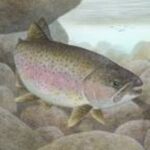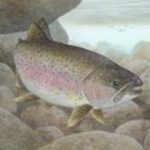In order to have the best chance of catching Rainbow Trout you need to have the proper gear. Lets start with the fishing pole. There are three basic types – the fly pole, the spin casting pole and the bait casting pole. I don’t have any experience with the fly pole so I will discuss the other two – the spin casting pole and the bait casting pole. Spin casting poles are best for using artificial lures. And bait casting poles are best, of course, for using natural bait. However, bait can be used quite effectively on a spin casting pole. And lures work very well using a bait casting pole. It’s a matter of personal preference. The best length of pole, for general purpose, is 6 feet for the spin casting pole and 5 1/2 feet for the bait casting pole. Choose one that is not too stiff or too flexible.
Each type of fishing pole is made for a particular type of reel. There are two basic types. The spinning reel, which has a wire bail. And a bait casting reel, which has a button on the bottom. The spool of fishing line is exposed and visible on the spinning reel. The spool of fishing line is enclosed inside the bait casting reel. When fishing for Rainbow Trout a small to mid-sized reel is best for general purpose fishing. The fishing line should be between 4-8 lb. test, depending on the size of reel and the size of trout in the particular area to be fished.
When fishing for trout using bait, night crawlers and salmon eggs have the best luck. Red salmon eggs usually work the best, but in some places orange works better. When choosing a hook for the bait, a size 10 worm hook and a size 12 egg hook work great for most places. When fishing with bait you also need sinkers to help cast away from the shore. Sinkers are small lead weights that are attached to the fishing line. Split shot sinkers are the best type to use when fishing for Rainbow Trout. The sinkers should be attached to the line about 2 feet above the bait. Add as many sinkers as needed for the particular area to be fished. If fishing in fast moving water more sinkers might be needed. And if fishing in smaller bodies of water use less weight. However, never use too many sinkers as this could spook the fish.
Using artificial lures can be the most challenging, and also the most rewarding way to catch Rainbow Trout. They can also be the most confusing, as there are many types and colors of lures to choose from. And what works well in one area may have no luck at all in other areas. The most successful colors for Rainbow Trout are red, yellow, green and black. A combination of red/black and yellow/black also work well. Choose small lures with about the same hook size as used with bait.
The two most popular types of lures for trout are spinners and spoons. Spinners have a blade that spins around the lure and flashes in the water when it is reeled in. Spoons are shaped roughly like a table spoon and wobble in the water when reeled in. Both of these types may take some practice to use effectively. A slight twitch of the pole after a cast, just as the lure is reeled in is sometimes needed to activate the spinning, or wobbling of the lure. Also a slight twitch of the pole, every now and then, as the lure is being reeled in, can sometimes bring a strike. Try different retrieval speeds when reeling in the lure. If you are not having any luck using a slow retrieval speed, try a faster speed.
How you use artificial lures or bait to catch Rainbow Trout depends on the body of water to be fished. Lakes and ponds are fished slightly different than rivers and streams. However, very large rivers are fished much the same as lakes. In lakes and ponds Rainbow Trout tend to hide among areas such as downed trees, overhanging branches, large rocks or aquatic vegetation. They usually come out of hiding and search for food in the early morning and evening hours, when insects are most active. They tend to hide and stay deeper during mid-day, when predators, both in the water and on land, are most active.
When fishing in lakes and ponds it is most important to be as quiet as you can when approaching the shore. Trout have very good hearing and they will hear a noisy person and quickly leave the area. Choose a spot that looks like it has good hiding places for trout. Keep in mind that early morning and evening hours are the times when trout are the most active. When fishing with bait a red and white bobber works well at keeping your bait at the right depth, depending on where the fish are. Fishing on the bottom, with no bobber, also works well. When using a lure cast close to areas where trout might be hiding. Try different colors and speeds of retrieval. Sometimes twitch the pole while reeling. If you don’t get any hits after several casts try a different spot.
Rivers and streams provide a different environment for Rainbow Trout than lakes and ponds. Since the water is flowing the fish tend to inhabit the calmer areas of the stream or river. They also tend not to roam around in search of food as much. They usually wait for the food to float by. They are most active, as in lakes, during the early morning and evening hours, when the insects are most active.
When fishing in rivers or streams look for the same types of cover as lakes, such as large rocks and downed trees, but fish in the calm areas just downstream from these obstacles. Also floating some bait or a lure along the turbulent area between the calm and swift parts of a river or stream can produce a strike. The mouths of rivers or streams can also be a good place to catch Rainbow Trout. In larger streams, where there is enough room, cast your bait or lure upstream and let it float downstream while you reel it in past obstacles where trout may be hiding.
Keep trying. Be patient and don’t get discouraged. Seek out those places where trout may be hiding. Fish during the times when they are most active. If you’re not having any luck, try something different. It may take some practice but by following these basic tips anyone can catch Rainbow Trout.





